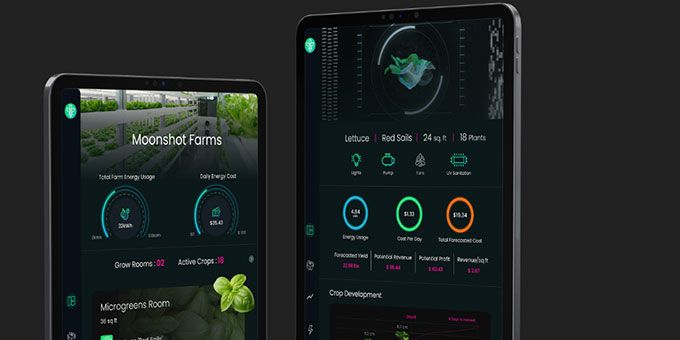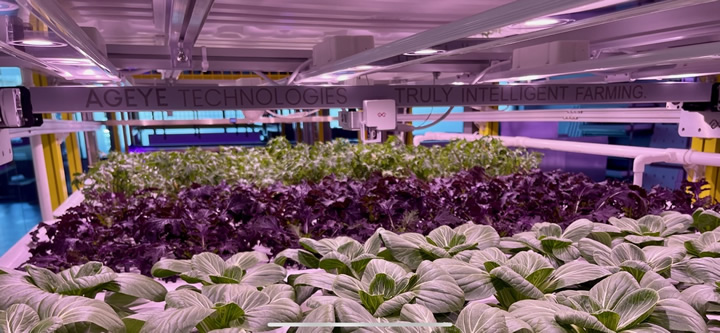While many farms currently approach their operations primarily from an agricultural perspective, it is worth noting that modern vertical farms share significant similarities with the manufacturing industry.
 The Next Phase of Development for Vertical Farming
The Next Phase of Development for Vertical Farming

Q&A with Bashir Jabbour, Head of product and implementation | AGEYE
Tell us about yourself and your role with AGEYE.
Hello! I'm Bashir Jabbour, and I am the head of product and implementation at AGEYE. With a background in industrial automation, I bring a strong understanding of integrating technology to optimize processes.
At AGEYE, we believe indoor farms are at the foundation of next-generation agriculture that's needed for a growing global population. We believe in a future where accessible, healthy, and sustainable food is not a luxury but a reality for everyone. From the creation of a sustainable food supply in areas that lack farmable land to facilitating rapid biomanufacturing of therapeutics and industrial additives, indoor farming has the potential to touch nearly every aspect of our lives. AGEYE represents an entirely new class of crop intelligence and farm management tools that equip growers with advanced automation, enhanced visibility, and optimized cost efficiency to create a clear path to profitability.
My role involves acting as a liaison between farmers and our internal teams, including software, hardware, and data science, to ensure that our technology meets the individual needs of each farm. We understand that every farm is unique and requires customized solutions that cater to their specific requirements. Our Digital Cultivation platform includes robotics, IoT sensors, and specialized imaging hardware that can be personalized based on the farm's needs. Therefore, I spend a significant amount of time working with customers to determine their needs and the most effective way to implement them.
What makes you so passionate about indoor farming and its importance to the food supply chain?
Indoor farming addresses some of the key challenges in traditional agriculture, such as limited arable land, climate change, and the need for year-round food production. As someone with an industrial controls background, I am motivated by the opportunity to develop innovative solutions that can help us get past these limitations. By utilizing vertical space and implementing controlled environments, indoor farming offers a scalable and sustainable approach to food production. This scalability is especially crucial as we strive to meet the increasing global demand for food in a resource-constrained world.
Indoor farming aligns with my passion for creating innovative and technologically advanced solutions. The use of automation and control systems in indoor farms allows for real-time monitoring, precise adjustments, and predictive analytics. This level of control and data-driven insights enable farmers to make informed decisions, optimize plant growth, and respond proactively to potential issues.

Based on your experience, what are the primary reasons why vertical indoor farms are failing?
It's no secret that indoor farms are difficult to run and often struggle to generate the margins needed to sustain operations. High labor and energy costs, along with limited quality control and siloed systems, make it difficult to manage them efficiently. Unfortunately, many indoor farms have been unable to reach profitability and have had to shut down due to a lack of visibility into their real operational costs on a per-plant level.
How does AGEYE’s expertise address and mitigate these factors?
That's an excellent question, and it brings to light an important aspect of vertical farming. While many farms currently approach their operations primarily from an agricultural perspective, it is worth noting that modern vertical farms share significant similarities with the manufacturing industry. In today's high-efficiency manufacturing plants, comprehensive tracking and quantification of products and inputs occur at every stage, encompassing factors such as reject rates, machine efficiency, input costs, and market demand. We firmly believe that adopting such principles in Controlled Environment Agriculture (CEA) represents the next phase of its development.
Currently, there are limited farms equipped to provide accurate insights into the true cost of an individual plant throughout its lifecycle, from transplanting to reaching store shelves. This is where AGEYE comes in. Our uniquely designed platform offers real-time, plant-specific data that spans every aspect of crop cultivation and facility management. From the moment a plant enters your farm to its distribution, our platform provides unparalleled visibility and insights.
By leveraging our technology, vertical farms can transition from relying on incomplete information and estimations to having precise, data-driven insights into their operations. This heightened level of transparency empowers farmers to make informed decisions, optimize resource allocation, and identify areas for improvement. By accurately tracking and quantifying the journey of each plant, farms can gain a comprehensive understanding of costs, streamline processes, and ultimately enhance the efficiency and profitability of their operations.
One of the challenges in vertical farming is optimizing resource utilization. How does AGEYE’s technology assist farmers in maximizing resource efficiency and reducing waste?
Efficient resource utilization is a critical factor in maximizing the productivity and profitability of vertical farming operations. The complexity of indoor farming often poses challenges in effectively planning and optimizing resource usage. At AGEYE, we understand these challenges and have developed technology to assist farmers in maximizing resource efficiency and reducing waste.
Our technology offers a range of resource utilization modules that address these issues. Let's explore how our modules can help in optimizing specific resources within a vertical farm.
For instance, consider the scenario where an operator aims to reduce the cycle time for a crop. They may decide to increase the photoperiod to accelerate plant growth. However, this change can have cascading effects on various resources throughout the farm. The increased photoperiod will consume more energy, generate additional heat, increase HVAC demands, and lead to higher water consumption due to increased plant transpiration.
With AGEYE's platform, quantifying these changes and their impact on resources is seamless and instantaneous. Our resource utilization modules provide real-time insights into changes in energy and water consumption. Moreover, they can forecast the real-world cost models associated with these changes, allowing operators to make informed and predictive decisions.
By leveraging our technology, farmers gain unprecedented visibility into resource utilization. They can monitor and optimize energy consumption, water usage, and other critical resources in real time. This empowers them to proactively manage their operations, identify inefficiencies, and implement adjustments to maximize resource efficiency.
Additionally, our platform enables farmers to precisely monitor and control environmental parameters such as temperature, humidity, and CO2 levels. By maintaining optimal conditions, farmers can ensure that resources are utilized efficiently and crops thrive, leading to consistent harvests and minimal waste.
Ultimately, AGEYE's technology equips farmers with the tools and insights needed to optimize resource utilization and reduce waste in vertical farming. We believe that by maximizing efficiency, farmers can achieve long-term sustainability and profitability in their operations.
How does AGEYE utilize data to help vertical farms make informed decisions and avoid potential pitfalls?
Our AI platform helps growers streamline their operations, reduce costs, and increase productivity. We use advanced sensors and machine learning algorithms to monitor and analyze crop health, environmental conditions, and other key metrics in real time. AGEYE's computer vision technology is like having a team of expert agronomists constantly monitoring every single plant on the farm. By providing per-plant visibility for every plant, for every cycle, farmers have access to detailed insights into the growth and development of their crops. This allows you to make data-driven decisions and optimize your operations for maximum yield.
AGEYE utilizes data in a comprehensive manner to empower vertical farms to make informed decisions and avoid potential pitfalls. Through our advanced technology platform, we enable farms to harness the power of data-driven insights in the following ways:
-
Real-time Monitoring: AGEYE's platform continuously monitors every aspect of the crop and facility, capturing data on plant growth, environmental conditions, resource utilization, and more. This real-time monitoring provides farms with up-to-date information on the performance and health of their crops.
-
Data Analysis: We employ cutting-edge analytics and machine learning algorithms to process the vast amount of data collected. By analyzing this data, AGEYE extracts meaningful patterns, correlations, and trends that provide valuable insights into crop behavior, resource usage, and overall farm performance.
-
Performance Benchmarks: AGEYE's platform establishes performance benchmarks based on historical data and industry standards. By comparing current crop performance against these benchmarks, farms gain a clear understanding of how their operations measure up and identify areas for improvement.
-
Predictive Analytics: Utilizing historical data and advanced modeling techniques, AGEYE's platform enables farms to forecast future crop growth, yield, and resource requirements. This predictive capability allows farmers to proactively adjust their strategies, optimize resource allocation, and mitigate potential risks.
-
Resource Optimization: By precisely tracking resource utilization, including water, energy, and labor, AGEYE's platform helps farms identify inefficiencies and optimize resource allocation. Farms can make data-driven decisions to maximize resource efficiency, reduce waste, and lower operational costs.
By leveraging data in these ways, AGEYE empowers vertical farms to proactively manage their operations, optimize performance, and avoid potential pitfalls. The ability to make data-driven decisions based on real-time information helps farms improve crop quality, increase productivity, reduce risks, and ultimately achieve long-term sustainability and profitability.
AGEYE recently announced a strategic partnership with HYVE. Can you elaborate on what this partnership entails and why it is significant for the industry?
This partnership aims to provide a comprehensive turnkey solution for growers. Our integrated solutions, which combine AGEYE's farm management expertise with HYVE's advanced automation and racking systems, will lead to more efficient use of resources and better yield optimization.
Consider this: AGEYE's farm management solutions provide data-driven insights that enable HYVE's automated systems to make real-time adjustments based on crop growth patterns and environmental conditions. This provides farmers with a comprehensive platform that manages not only the cultivation process but also the physical infrastructure and automation involved.
The partnership could enable farmers to manage larger facilities with greater ease and consistency, as automation and data analytics could handle many of the complex tasks involved.
We believe that our partnership will stimulate the overall growth of the indoor farming industry. As integrated solutions become more sophisticated and efficient, more farmers and investors might be drawn to adopt these technologies, leading to greater acceptance and adoption of advanced practices that push the boundaries of what's currently possible in indoor agriculture.
This collaboration will lead to improved efficiency, scalability, and innovation, ultimately driving the industry forward and benefiting farmers, consumers, and the environment.
What does the future look like for indoor farming and how do you see your solution evolving and improving in the future to better meet the needs of indoor farming operations?
The future of indoor farming holds exciting prospects, driven by technological advancements and sustainability priorities. As indoor farming embraces automation and AI integration, AGEYE's farm management solutions are poised to evolve accordingly. With precision agriculture techniques and AI-driven insights, the solutions will tailor growth plans for individual crops, optimizing factors like lighting, humidity, and nutrients. Energy efficiency will be prioritized through dynamic control systems, while remote monitoring and integration with other technologies like vertical farming systems will enhance operational control.
Sustainability and data security will remain central, alongside continuous learning capabilities that refine predictions and recommendations. AGEYE's solutions will play a pivotal role in shaping the future of efficient, data-driven, and sustainable indoor farming.
The content & opinions in this article are the author’s and do not necessarily represent the views of AgriTechTomorrow
Comments (0)
This post does not have any comments. Be the first to leave a comment below.
Featured Product

